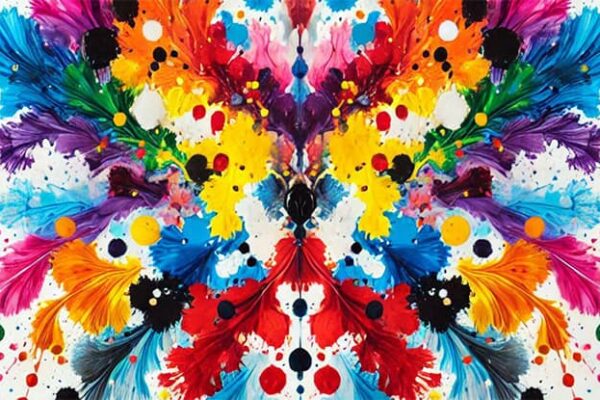Creative approaches in psychology play a key role in developing new therapeutic techniques. They allow psychologists to expand their toolkit and offer clients unconventional ways to address their issues. One such creative method is using cling film as a tool in art therapy.
Cling film, typically used for food storage, possesses unique properties that make it an interesting material for art therapy. Let’s explore these properties in detail:
- Transparency: Cling film is transparent, allowing the creation of multilayered compositions that explore depth and perspective.
- Elasticity: The film stretches easily, enabling the creation of various shapes and textures.
- Stickiness: Its ability to adhere to different surfaces, including itself, opens up possibilities for creating three-dimensional structures.
- Lightness: The material is very light, making it suitable for use with individuals of all ages and physical abilities.
- Water resistance: This property allows it to be combined with paint and other wet materials.
- Safety: Cling film is non-toxic and safe for use, which is especially important in a therapeutic setting.
Using cling film in art therapy offers several notable advantages:
- Accessibility: Cling film is inexpensive and readily available in most stores, making this method accessible to a wide range of specialists and clients.
- Novelty: The unconventional use of a household item in therapeutic settings can stimulate clients’ interest and creativity.
- Versatility: The film can be used in various ways, such as for painting, creating sculptures, collages, and more.
- Sensory stimulation: Working with cling film engages tactile sensations, which is especially beneficial for people with sensory disorders.
- Ease of use: The film requires no special skills or tools, making it accessible to individuals of different ages and abilities.
- Opportunity for experimentation: The unique properties of cling film allow for the creation of unusual effects, encouraging experimentation with forms and textures.
- Eco-friendliness: With proper usage, the film can be recycled, making this method environmentally friendly.
These advantages make cling film a valuable tool in an art therapist’s arsenal, broadening the range of therapeutic techniques and approaches available.
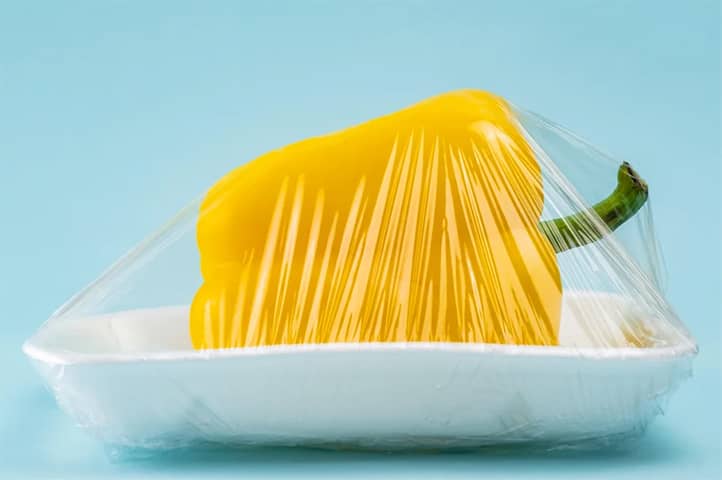
Methods of Using Cling Film in Art Therapy
One of the most effective methods of using cling film in art therapy is the “wrapping” technique, which takes advantage of the film’s ability to cling tightly to surfaces of various shapes and textures.
The “wrapping” process can be applied to both inanimate objects and parts of the client’s body (such as hands or legs). During this process, the client can experience a wide range of tactile sensations that can evoke various emotional responses and associations.
The “wrapping” technique can be used to:
- work with bodily sensations and body image;
- explore personal boundaries;
- relieve muscle tension;
- create a sense of security and comfort.
It is important to note that this technique should be conducted under the supervision of a qualified psychologist, who can correctly interpret the client’s reactions and ensure the safe conduct of the procedure.
Creating Textures and Patterns
Another intriguing method of working with cling film is creating a variety of textures and patterns. This process can be a standalone therapeutic technique or part of a more complex composition.
To create textures, the following approaches can be used:
- crumpling the film to create three-dimensional structures;
- applying paint to the film and then distorting it;
- making impressions of various objects on the film;
- heating the film to alter its structure (under the supervision of a specialist).
The process of creating textures can be very meditative and calming. It allows the client to focus on tactile sensations and visual effects, distracting them from negative thoughts and emotions.
Combining with Other Materials
Cling film pairs well with other materials, providing extensive creative possibilities in art therapy. Here are some examples of combinations:
- Film + paint: Paint can be applied to the film, or it can be drawn on with markers to create transparent, colorful compositions.
- Film + paper: The film can be used to create collages by combining it with magazine cutouts or drawings on paper.
- Film + natural materials: Leaves, flowers, and twigs can be “sealed” between layers of film, creating unique natural compositions.
- Film + fabric: Combining film with various fabrics can create interesting textural effects.
- Film + modeling clay: Three-dimensional sculptures can be made by using clay as a base and covering it with film to create a smooth surface.
Combining different materials not only expands creative possibilities but also symbolizes the integration of various aspects of the client’s personality or life experiences.
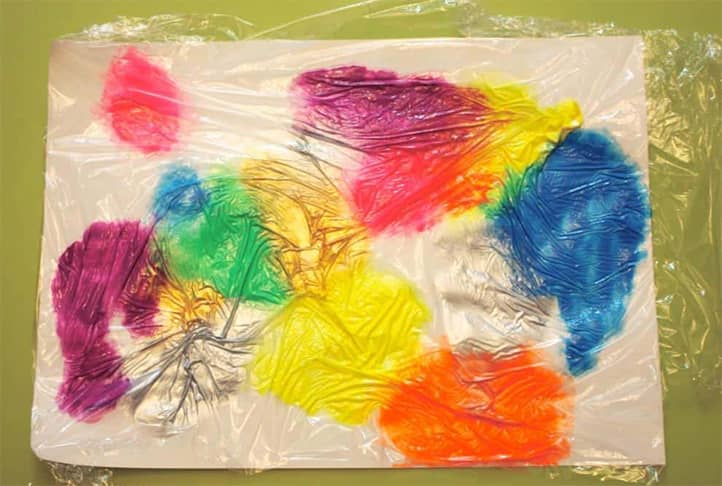
Psychological Aspects of Working with Cling Film
Using cling film in art therapy actively engages tactile sensations, which has a profound psychological impact on the client. Tactile stimulation plays an important role in our emotional and cognitive development from a very early age.
When clients work with the film, they encounter various tactile sensations:
- smoothness and slipperiness of the surface;
- elasticity when stretching;
- lightness and airiness of the material;
- stickiness when layers adhere.
These sensations can evoke different emotional responses and associations. For instance, the smoothness of the film can be associated with comfort and safety, while its elasticity may symbolize flexibility and adaptability.
Tactile interaction with the film can also assist in:
- Reducing anxiety: Rhythmic, repetitive actions with the film have a calming effect.
- Improving concentration: Focusing on tactile sensations helps to concentrate on the present moment.
- Developing sensory integration: Particularly beneficial for individuals with sensory disorders.
- Releasing emotions: Physical interaction with the material can help express emotions that are hard to put into words.
It’s important for the psychotherapist to carefully observe the client’s reactions to tactile stimulation and use these observations in further work.
Enhancing Creativity
Using nontraditional materials like cling film in art therapy can significantly stimulate clients’ creativity. This happens for several reasons:
- Novelty of the material: The unconventional use of a household item for creative purposes can “unlock” creative potential.
- Lack of set rules: Unlike traditional art materials, working with film doesn’t have established techniques, which encourages experimentation.
- Unpredictability of results: The unique properties of the film often lead to unexpected effects, which stimulate the creative process.
- Ability to correct “mistakes”: The pliability of the film makes it easy to alter creations, reducing the fear of failure.
- Multisensory experience: Engaging various senses (sight, touch) can stimulate new ideas and associations.
Enhancing creativity through work with cling film has a positive impact on various aspects of the client’s life:
- improving self-esteem through creating unique works;
- developing problem-solving skills;
- enhancing emotional flexibility;
- fostering creative thinking.
The therapist can encourage creativity by guiding clients toward experimenting with the film and supporting their creative attempts.
Relieving Tension and Stress
Working with cling film in art therapy can be an effective method for relieving tension and stress. This effect is achieved through several factors:
- Physical activity: Manipulating the film involves various movements that help relax muscles and reduce physical tension.
- Focusing attention: Concentrating on the process of working with the film helps distract from stressful thoughts and experiences.
- Sensory stimulation: Tactile sensations from interacting with the film soothe the nervous system.
- Playful element: The unconventional nature of the material can bring a playful aspect to therapy, which helps reduce stress levels.
It is important to note that the process of tension relief through cling film can be both conscious and unconscious. The client may purposefully use film techniques for relaxation, or stress relief may naturally occur through creative activity.
The therapist can facilitate the tension-relief process by offering exercises that focus on bodily sensations when working with the film. For example, clients could be asked to pay attention to the feeling in their hands while stretching the film or to notice any changes in their breathing when creating a three-dimensional composition.
Additionally, working with cling film can be an effective way to express and transform negative emotions. Clients can symbolically “wrap” their problems in the film, create representations of their fears and then transform them, or use the film to create a protective “cocoon” that offers a sense of safety.
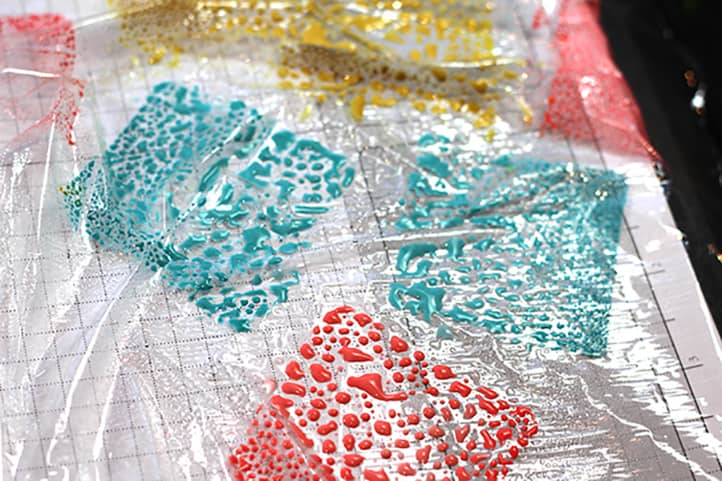
Practical Examples of Exercises
Individual exercises using cling film in art therapy can be highly varied and tailored to the client’s specific needs. Here are a few examples of such exercises.
- “Emotional Landscape”: The client is invited to create an abstract composition reflecting their emotional state. This can involve different techniques with cling film, such as stretching, crumpling, and layering. Colors can be added using markers or acrylic paints. This exercise helps the client visualize and acknowledge their emotions, offering an opportunity to transform them during the creative process.
- “Personal Boundaries”: In this exercise, the client uses cling film to explore their personal boundaries. They might create a “shell” around themselves or a part of their body, then observe how they feel within this shell. This helps address issues related to personal space, self-protection, and interactions with others.
- “Transforming Negativity”: The client is asked to visualize a negative emotion or problem, creating a representation of it with cling film. Then, through various manipulations (stretching, rolling, cutting), they transform this image into something positive. This exercise can aid in processing negative emotions and exploring new perspectives.
- “Tactile Diary”: Over a specific period (such as a week), the client creates a small cling film composition each day to represent their mood or a key event of the day. At the end of the period, all compositions are combined into a single installation. This exercise encourages self-awareness and can be helpful in managing chronic stress or depression.
Group Activities
Group activities with cling film in art therapy can be a powerful tool for developing communication skills, empathy, and group cohesion. Here are some examples of such activities.
- “Collective Installation”: The group creates a large cling film installation, with each participant contributing their element. This activity fosters collaboration skills and can be used to work on group dynamics. During the creation process, participants interact, find compromises, and learn to value each other’s contributions.
- “Non-Verbal Dialogue”: Participants form pairs and create a joint composition from cling film without speaking. This exercise builds non-verbal communication and empathy. Afterward, pairs discuss their experience, sharing impressions of how easy or challenging it was to interact without words.
- “Emotional Mirror”: Participants work in pairs. One participant creates an image of their emotion using cling film, while the other tries to reproduce this image, “mirroring” their partner’s emotion. This exercise enhances empathy and emotional recognition skills. Afterward, participants discuss how accurately they were able to “read” and recreate their partner’s emotion.
- “Group Story”: The group creates a series of interconnected cling film compositions that together tell a story. Each participant is responsible for their part of the story. This activity encourages creativity, collaboration skills, and can be used to explore group narratives and collective memory.
It is important to note that during group activities with cling film, the therapist should pay close attention to group dynamics and individual reactions. Some individuals may feel uncomfortable with close physical contact or working with an unconventional material.

Results and Benefits of the Method
The use of cling film in art therapy can have a significantly positive impact on clients’ emotional well-being. This method allows clients to express and process their emotions in a safe, creative way.
Working with cling film helps reduce anxiety and stress levels. The tactile sensations from interacting with cling film have a calming effect, helping the client “ground” themselves in the present moment. Additionally, creating something new and unique from a simple material boosts self-esteem and a sense of self-worth.
This method can also be effective in working with negative emotions, such as anger or frustration. Clients can physically express these emotions (e.g., by stretching or crumpling the cling film), which can lead to emotional release and relief.
Improvement in emotional well-being often occurs gradually, through regular work with this method. The therapist should closely monitor the client’s emotional responses and adapt the therapeutic process according to each individual’s needs.
Development of Self-Expression
Working with cling film in the context of art therapy opens new possibilities for clients’ self-expression. The unique properties of this material allow the creation of diverse forms and structures, helping to convey aspects of their inner world that may be difficult to put into words.
Using an unconventional material provides an opportunity to go beyond typical forms of self-expression. This is especially beneficial for those who struggle to verbalize their thoughts and feelings. By creating abstract or symbolic images with cling film, clients can express complex emotions or ideas that are hard to articulate.
Moreover, the process of working with cling film encourages creativity and spontaneity. Since this material lacks established rules for use in art therapy, clients have the freedom to experiment and discover their own unique ways of working with it. This can lead to the discovery of new facets of themselves and their creative potential.
It is important to note that developing self-expression through working with cling film positively influences other areas of clients’ lives. Mastering skills of creative self-expression aids in more effectively communicating their needs and emotions in everyday life, potentially improving interpersonal relationships and overall quality of life.
Psychotherapeutic Effect
The psychotherapeutic effect of using cling film in art therapy can be multifaceted and profound. This method has the potential to affect various aspects of clients’ psychological well-being.
One key therapeutic effect is the safe expression and transformation of negative emotions. Working with cling film allows clients to express their fears, anxieties, or anger in a symbolic form, then transform these images, leading to emotional relief and insights.
Another important therapeutic aspect is the development of body awareness. Tactile interaction with cling film helps clients better sense their bodies, which is especially beneficial for those with difficulties in body awareness or suffering from psychosomatic conditions.
Working with cling film can also foster resilience and adaptability. The pliability and flexibility of the material serve as a metaphor for developing these qualities in the client. The process of creating, transforming, and adapting cling film artworks can help clients adopt a more flexible approach to life challenges.
Additionally, this method is effective for trauma work. Creating “protective shells” from cling film allows clients to feel more secure, an important step in the healing process from psychological trauma.
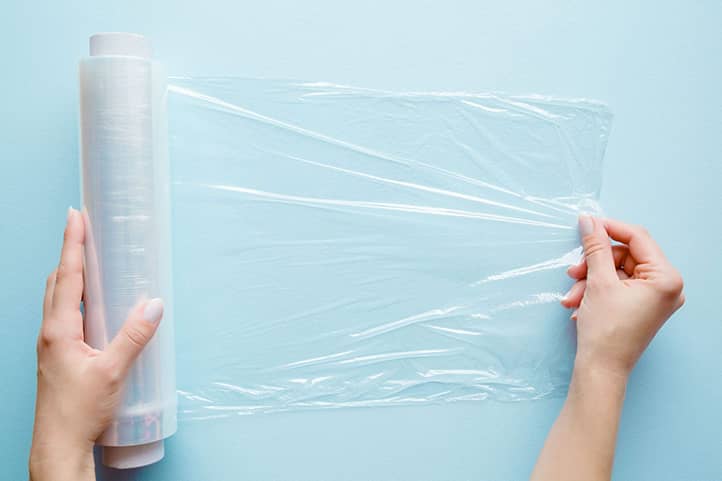
Outcomes of the Method’s Effectiveness
The use of cling film as a means of art therapy shows great potential within contemporary psychotherapeutic practice. This method offers a unique approach to working with emotions, self-expression, and clients’ psychological well-being.
The method’s effectiveness is based on several key factors:
- Unconventional Material: Stimulates creativity and innovative thinking, potentially leading to new insights and problem-solving approaches.
- Tactile Interaction: Provides strong sensory stimulation, especially helpful for clients struggling with verbal expression of emotions or experiencing psychosomatic symptoms.
- Pliability and Flexibility of Cling Film: Serves as a powerful metaphor for developing psychological flexibility and resilience.
Results show a positive impact on clients’ emotional states, reduced stress and anxiety, improved self-expression, and enhanced creativity. The method is especially effective in trauma work, where creating “protective shells” helps restore a sense of safety and control.
However, as with any therapeutic method, the use of cling film in art therapy has limitations. Not all clients may feel comfortable working with this material, and the method’s effectiveness can vary depending on individual characteristics and needs. Therefore, it is essential for the therapist to carefully assess the appropriateness of this method for each specific case.




